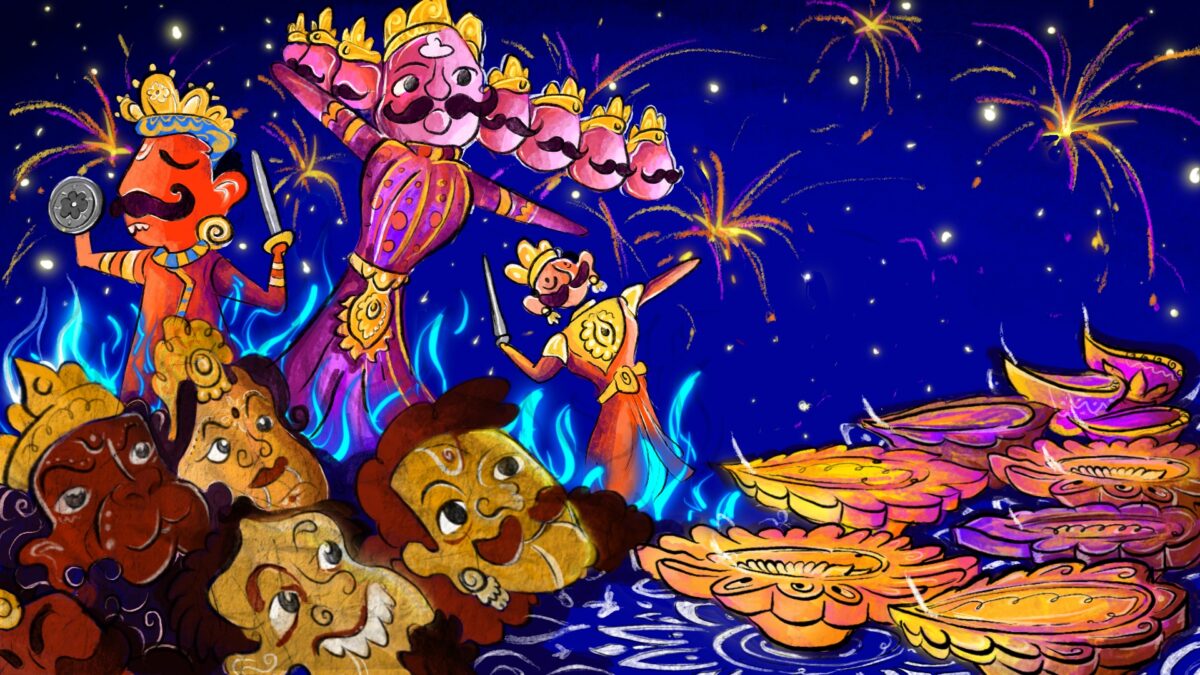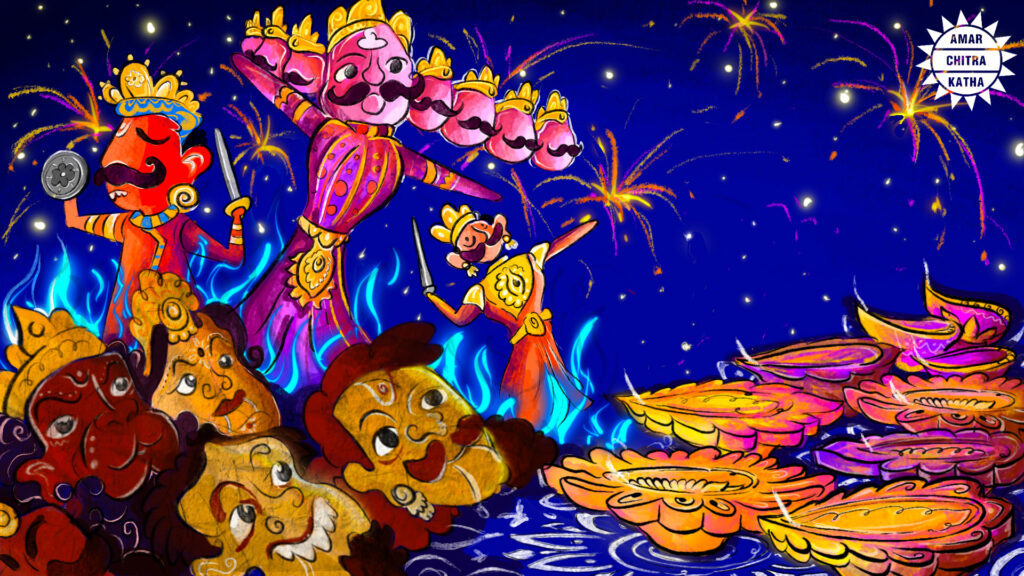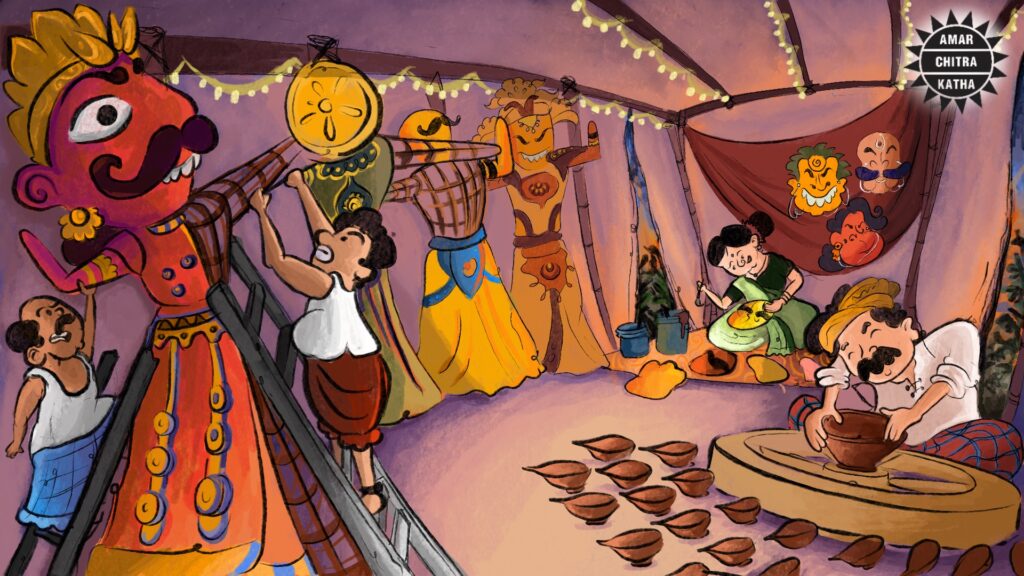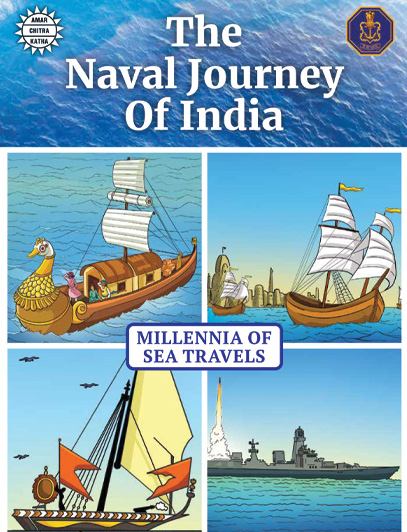The Artisans of Diwali and Dussehra
- October 16, 2025


The Artisans of Diwali and Dussehra
- October 16, 2025
by Keya Gupta
The festive season is filled with beauty. Flowers, rangolis, and diyas transform neighbourhoods for Dussehra and Diwali. These crafts are so woven into our celebrations that they often seem invisible. But who makes these objects, and what goes into making them?
As early as August, the work for Dussehra’s biggest spectacle, the burning of grand Ravana effigies, begins. In Delhi’s Titarpur and across northern India, this is a months-long family affair of turning bamboo and cane into massive figures, some reaching up to 40 feet!
To receive more such stories in your Inbox & WhatsApp, Please share your Email and Mobile number.
Effigy makers start by sourcing bundles of bamboo from local wholesalers. These are then split, bent, and woven into massive skeleton frames, a lightweight yet sturdy base that supports cloth and papier-mâché. Each body part is made separately: the torso, arms, legs, and, most importantly, the ten heads. All the features are exaggerated. Ravana is depicted with bulging red eyes and flared moustaches, made from papier mache, where glue and paper are alternatingly layered.
After days of drying, the frames are painted in vivid traditional colours, decorated with sequins and vibrant fabrics, and dressed grandly. Firecracker garlands are carefully put in after all the decorating has been done, for the final dramatic burning. The work is collaborative; with the women and children also helping with colouring and assembly.

On Majuli Island in Assam, the complex and vibrant masks of Ramlila are more than a source of livelihood; mask-making is a historic tradition passed down through centuries. This tradition is nurtured by the Satra community. Master craftsmen like Hemchandra Goswami and Haren Goswami are passing down the knowledge to apprentices, keeping it alive in the new generation.
Masks of characters such as Rama, Hanuman and Ravana are made using split bamboo, cane, clay, cow dung, cotton cloth, and pith; a soft cork-like material. Craftsmen make bamboo frames which are then layered with cotton cloth dipped in a mixture of clay or cow dung. Each layer is painstakingly sundried. Each layer adds more details, and the mask grows more elaborate. Craftsmen add features like blinking eyes, moving mouths and eyebrows to make the features more expressive.
The craft is kept alive both as a means of livelihood and a marker of cultural identity. Mask making is seasonal, ramping up during festival months but often supported by teaching workshops and tourism the rest of the year. As outside interest grows in the craft, artists have even adapted it across secular lines to make masks for a wide range of art and performances.
The diya might be smaller and simpler than the intricate effigies and masks, it is inseparable from the festival: every home glows with its presence.
In the months leading up to Diwali, Kumhar and Kumbhar potter families shape thousands of diyas. Each diya begins with clay, sourced from riverbanks or the Western Ghats. The clay is then sifted for impurities, kneaded with water and shaped into diyas on a wheel by hand. Once the diyas are shaped, they are sundried and baked in makeshift kilns fuelled by scraps of wood and carboard. They are often painted and decorated by women and children before being taken to the market.
For many families, Diwali is the busiest and most profitable part of the year, but the work is physically demanding, with cramped workshops and health risks. The kiln fumes while firing the diyas also pose an environmental challenge. Despite this, potters persist, driven by tradition, skill, and necessity.

The artisans behind these crafts – effigy makers, mask artists, and potters – are not just preserving tradition, they are also adapting to new challenges. Their skills carry centuries of culture and have shaped how communities celebrate these festivals. Artisan livelihoods, like the festivals themselves, are seasonal: intense and rewarding, but brief. For a few weeks, demand increases and communities come together, working with tradition. Supporting these local artisans as we carry out our own festivities does not just ensure that the season remains beautiful, but that the ancient traditions remain alive a bit longer.
To read stories about Diwali and Dussehra, download our very own ACK Comics App.
To receive more such stories in your Inbox & WhatsApp, Please share your Email and Mobile number.

Comic of The Month
The Naval Journey of India Book I
This book is the first of a three-book series that takes a deep and detailed look at India's Naval History and a deep insight into the lives of our men and women in white. But any series on the Indian Navy has to start at the very beginning - exploring India's celebrated maritime history. Join our little hero, Bharat, and his grandfather, Commodore Sagar, as they sail into the deep blue waters of time. Book I of The Naval Journey of India takes a sweeping look at India's maritime endeavours, how the seas impacted us over millennia and how the oceans made us who we are.